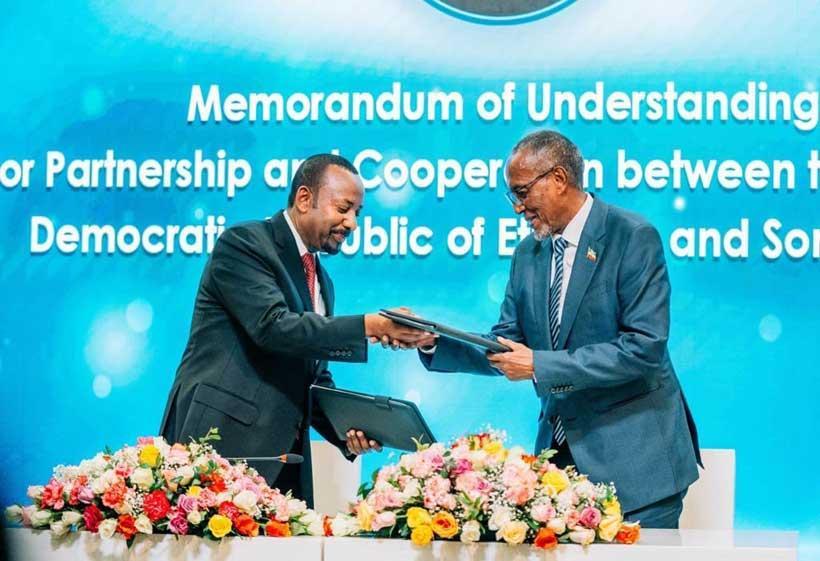By
Erestu Legese Beyene
Africa-Press – Eritrea. When Ethiopia’s prime minister revived his call for sea access in early 2024, regional headlines lit up overnight. It was not just about trade or logistics, at least not entirely. It reopened a decades-old wound, the kind that never really heals in the Horn of Africa: who controls the coast, and what that means for everyone else. Thirty years following Eritrean independence, Ethiopia’s maritime ambition forced an old question back into view. Will port infrastructure foster regional harmony or merely intensify tensions under the guise of economic development?
Despite shiny, substantial terminal construction, global maritime networks, and massive capital flows, the Horn remains one of the world’s most unstable coastal regions. Trade, once seen as the great peacemaker, has not eased political divides. Gartzke (2003) argued that commerce can stabilize relationships only when trust already exists. In the Horn, that trust is painfully scarce.
The Paradox of Prosperity and Instability
The Horn’s port boom was supposed to bring shared prosperity; instead, it has deepened divisions. Djibouti’s rise as a logistics hub, Ethiopia’s ongoing pursuit of maritime routes, and new capital projects in Eritrea, Somalia, and Sudan all began with high expectations. However, scholars like Cardoso and Potgieter note that these projects have increased disparities rather than reduced them.
Throughout the region, governments view ports not as political tools but as strictly economic assets. Maritime access holds deep emotional and historical significance, especially for Ethiopia, which has been landlocked since 1993. Its maritime ambitions are partly about memory and partly about necessity. Eritrea, wary of any Ethiopian attempt to regain access to the Red Sea, sees such ambitions as an existential threat. Meanwhile, Djibouti benefits from Ethiopian dependence, with little motivation to change this dynamic. What could have been a shared maritime vision has instead become a series of competing survival strategies. Regional integration has not ended rivalries; it has simply formalized them.
A Strategic Landscape of Global and Domestic Interests
Geography has embedded inequality into the Horn’s maritime region. Ethiopia’s reliance on Djibouti gives the smaller nation significant influence. Eritrea keeps strict control over its borders, while Somalia’s political division allows outsiders to negotiate directly with autonomous areas, such as Somaliland. The Ethiopia-Somaliland Memorandum of Understanding, signed in January 2024, offering land access in exchange for port rights and possible recognition, illustrates this tension well. It was more about sovereignty than trade.
International actors, of course, have taken notice. Gulf states, especially the UAE and Saudi Arabia, view the Red Sea as a strategic backyard and have financed ports from Berbera to Port Sudan. China, through its Belt and Road Initiative, established its first overseas military base in Djibouti while investing heavily in regional infrastructure. As researchers like Getahun (2023) and Ylönen (2022) warn, these investments often prioritize access and influence over long-term stability. The result is a coastline that looks like a patchwork of foreign spheres of influence, each more closely connected to Dubai or Beijing than to neighboring states.
When Trade Fuels Tension
The liberal idea that trade connections reduce conflict hasn’t proven true here. Infrastructure built to link countries has often increased mistrust instead. Ethiopia’s transit agreements, Gulf-funded terminals, and competing port projects move forward without real coordination. They overlap, compete, and duplicate efforts. The result is a region with plenty of infrastructure but lacking in cooperative strategies.
IGAD’s Red Sea Task Force was meant to coordinate maritime governance and prevent countries from overstepping each other. However, political divisions and weak institutions have rendered it mostly symbolic. Without shared protocols for access, rights, tariffs, or security, each country treats maritime connectivity as a zero-sum game. Historical conflicts, especially between Ethiopia and Eritrea, continue to block efforts for collective management. The result is a strange paradox: the Horn has never been more economically connected, yet politically it’s falling apart. Trade moves faster than trust.
The New Race for the Horn
Ports in the Horn have become the frontline in global competition. Gulf nations use them to project regional influence; China solidifies its power through infrastructure; Western navies patrol nearby under the guise of anti-piracy or counterterrorism. As Tewolde (2024) stated, these converging interests threaten to turn the Horn into a strategic war zone rather than a cooperative maritime region.
Foreign investment drives short-term growth but also fosters dependency. Most countries negotiate port deals individually, often in secret, trading regional influence for immediate financial gains. Instead of uniting as a bloc, nations seek different patrons, dividing the region into small bargaining units for larger powers. In their pursuit of security from foreign sources, the Horn might be relinquishing control over its own waters.
Policy Pathways for Stability
If stability is ever to take hold, it won’t come from building more ports but from fostering better cooperation. The region doesn’t lack infrastructure; it lacks coordination. A few steps could start to transform competition into something more constructive.
First: The Horn needs a regional Ports Council, possibly under IGAD or the African Union, to coordinate tariffs, investment rules, and dispute resolution. Even a simple framework could reduce overlapping projects and foster some trust.
Second: Countries of the Horn could collaborate on infrastructure planning, sharing corridors, logistics, and data, similar to the ASEAN or East African Community precedents. That would shift port development from rivalry to a focus on efficiency.
Third: Horn states must renegotiate how they handle external powers. Acting collectively would strengthen their bargaining position and ensure that foreign investment supports regional priorities instead of external rivalries.
These steps are already embedded in the spirit within IGAD’s Red Sea Task Force and the AU’s Blue Economy Strategy. What’s missing is political will and possibly imagination to go beyond national ego.
From Competition to Collective Maritime Security
The Horn’s future won’t depend on who builds the next port but on who establishes the next framework of trust. The region has seen successive imperial powers and redrawn boundaries, yet the core pattern remains the same: external manipulation combined with internal suspicion. Today, these dynamics are expressed through trade infrastructure and investment agreements instead of military campaigns and territorial disputes.
Genuine stability, as Maxted and Zegeye (2002) argued, doesn’t begin with weapons or even with wealth; it starts with institutions that can balance interests with interdependence. For the Horn, that means viewing ports not as trophies but as shared assets.
The truth is, the Horn already has enough ports. What it needs is the political imagination to turn them from flashpoints into building blocks for peace. Until that occurs, every new port constructed might only deepen the region’s oldest divide, the one between ambition and trust.
The Horn of Africa already has enough ports; what is missing are new channels of trust to transform them from flashpoints into pillars of peace.
moderndiplomacy
For More News And Analysis About Eritrea Follow Africa-Press







